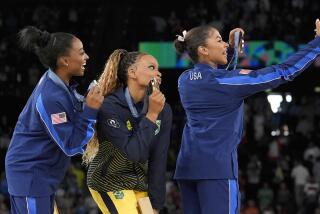Conference Will Explore ‘Dismal’ Fitness
- Share via
Calling the overall level of fitness of American young women “dismal,” the Women’s Sports Foundation, Girls Club of America and National Assn. for Girls and Women in Sport will explore the issues and problems in providing athletic opportunities to girls aged 5 to 18 at a national conference June 19-21 in Indianapolis.
The participating organizations have found that despite legislation for equal opportunity in school sports, programs for girls still receive less money, poorer coaching, less access to facilities and only one-tenth the media coverage of boys at the high school level. Only 15% of the participants in after-school sports are girls, and girls receive two-thirds less instruction time in physical education than boys.
Conference organizers have found that when a boy reaches school age lacking sports skills, schools make a real effort to teach him, but that this is rarely the case for girls in the same position.
Besides the health and fitness benefits of sports, girls miss out on important social and psychological experiences when their physical education is neglected. “Sport is one of the strongest socializing factors in any society,” the conference brochure pointed out. “The games you play as a youth are preparation for playing the games of life. Self-discipline, time management, dealing with pressure, coping with failure and teamwork are a few of the lessons learned on the playing field.” In addition, it is thought that when a girl grows up with inactive toys, such as dolls, rather than active play, it affects her ability to understand spatial concepts and perform eye-hand tasks. Research has found that girls who participate in school sports are more likely than non-athletic girls to excel academically and be student leaders.
Along with experts on sports for young people, the conference will feature speeches by women stars including Harlem Globetrotter Lynette Woodward, Olympic gold medal gymnast Julianne McNamara, Olympic gold medal swimmers Tracy Caulkins and Nancy Hogshead, and others.
Brenda Eskenazi, assistant professor in maternal and child health and epidemiology in the School of Public Health at UC Berkeley, has been chosen to receive the second annual Prytanean Faculty Enrichment Award.
The Prytanean Alumnae Inc., founded in 1901 on the campus, was one of the first women’s honor societies at an American University. The 2-year-old Faculty Enrichment Award, which includes a $10,000 grant, recognizes outstanding young women faculty members.
Since coming to Berkeley from Yale in 1984, Eskenazi has instituted courses on the reproductive hazards of industrial chemicals and reproductive epidemiology and developed the doctoral program for the Maternal and Child Health Program.
She plans to use the grant to hire one or two women graduate students as research assistants to collect data at prenatal clinics on pregnant women’s occupations and exposures to industrial chemicals and other potential hazards in the workplace.
Latina professional women are very successful people, according to a nationwide survey conducted recently by the National Network of Hispanic Women.
The average respondent to the survey earned $45,000 a year--nine times the average income of American women--and respondents reported wide civic involvement, good physical and emotional health, and balanced family lives.
“The survey challenges certain myths about Latina women,” said Ruth Zambrana, assistant professor at UCLA’s School of Social Welfare, and author of the survey report. “The myths are, in part, that Latina women are not leaders, that they do not work, that their primary function is home and babies. This study shows that, if given the opportunity, Latinas can achieve worldly success.”
The survey was mailed to members of the National Network of Hispanic Women who had managerial or entrepreneurial positions in a variety of fields.
The average respondent was 38, married with one or two children, and a middle- to senior-level management position. About a quarter of them were born outside the United States. Most had college degrees. All reported that they’d had to overcome obstacles to success including lack of mentors, lack of access to the mainstream society network, lack of advancement opportunities, lack of an advanced degree and the absence of affirmative-action policies for Latinas.
Zambrana hopes the findings will make available more funding for systematic research on the Latino community. “Most of the studies of the 1950s, ‘60s and ‘70s concentrated on those (Latinas) who failed to make it,” she said. “This stereotypes the whole group. It insinuates that Hispanics cannot make it. But they can if given the opportunity, and this survey proves it. Perhaps even more Hispanics could make it if they knew more about those who have made it.”
More to Read
Go beyond the scoreboard
Get the latest on L.A.'s teams in the daily Sports Report newsletter.
You may occasionally receive promotional content from the Los Angeles Times.






